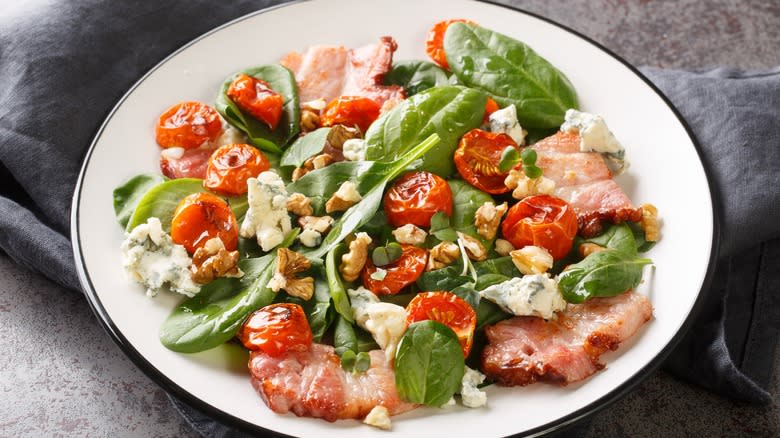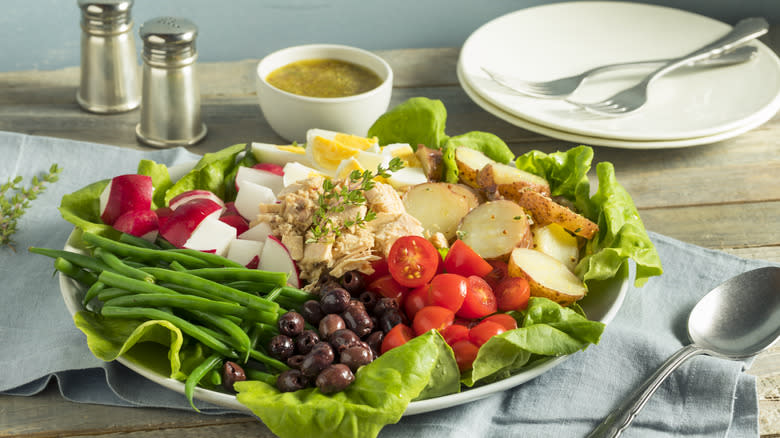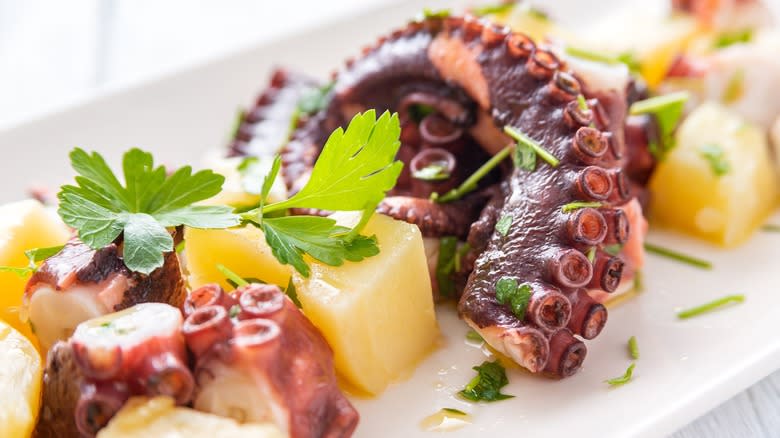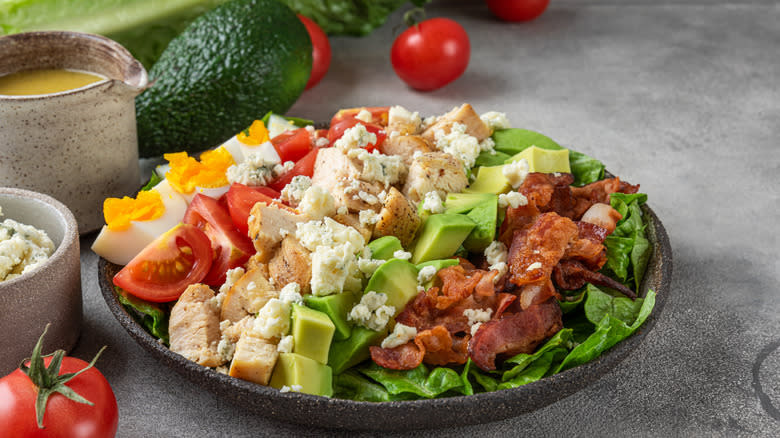Salade Composee Is The Parisian Dish That Keeps Leafy Greens Nicely Neat

The French have their own unique way of cooking just about everything, including their own onion soup, which is very different from English onion soup. Naturally, they also have a special way of making salad. Salade composée, which translates to composed salad, isn't as much a recipe as it is a philosophy of how to treat salad ingredients. While many of us toss our chopped lettuce leaves, vegetables, nuts, and sliced chicken breast into a bowl along with oodles of dressing, salade composée prioritizes presenting each ingredient so it is clearly visible on a plate rather than in a bowl.
Salade composée is basically the antithesis of the best salads at Sweetgreen. Sweetgreen's offerings have ingredients chopped so finely that they're practically minced before being thrown together in a bowl. This method optimizes salads for quick consumption between hurried phone calls in the office and trips to the gym. As France is a country known for its hours-long meals, it makes sense that their salads would feature larger cuts of vegetables that take longer to eat. This allows you to really savor each bite. Salade composée can be made up of an endless list of ingredients but there are a few principles to follow.
Read more: 7 Nuts You Should Be Eating And 7 You Shouldn't
The Rules Of Salade Composée

French cuisine is known for its strict, ubiquitous food rules, extending all the way to salads. While some people consider salads to be after-thoughts and side dishes, French dining takes the salad seriously. That care shows in the preparation and presentation of a salade composée. This unique preparation begins even in washing and drying the lettuce leaves, which must be done precisely and thoroughly. That attention to detail is what makes the salade composée such a refined dish.
There's no one recipe for a salade composée, but a classic example of one is the salade Niçoise, a French salad that has whole baby gem leaves, tuna, halved potatoes, olives, green beans, tomatoes, and hard-boiled eggs, amongst other things. The ingredients are assembled on a shallow, flat plate, and laid out in different groups, such as rings, wedges, rows, or artfully arranged clusters to create contrast between each ingredient. The salad is then treated to a drizzle of vinaigrette before being served — no tossing to be seen.
Salade Composées Around France

It won't come as a surprise that popular salade composée recipes are very much tied to diverse regions around France. The Lyonnaise and Niçoise salads are both named for the cities they come from -- Lyon and Nice, respectively. What is popular in the south of France will differ from the north because its inhabitants will have access to different ingredients and will have been brought up in different culinary traditions.
For example, salads from southern coastal France on the border with Spain often use fresh seafood, as in salade de poulpe. That recipe pairs octopus with capers, fennel, onion, and potatoes. Northern Alsace, which neighbors Germany, has a heartier, much meatier salad called salade de saucisse, or sausage salad, which has its roots in Bavaria and features slices of onions, sausage, and vinaigrette. Salade Aveyronnaise, which of course hails from Aveyron, offers baby spinach, bacon, garlic, nuts, and Roquefort cheese. All of these, if prepared and presented correctly, could qualify as French salade composée.
What Ingredients Can Go In A Salade Composée?

Another key to French-style salade composée is ensuring that the salad actually works as a main course. Chefs achieve this by using a variety of ingredient types, not just vegetables. Proteins in the form of meats or eggs, fats from cheese, pancetta, and oil, and of course crunchy, carby croutons do a wonderful job at making the salad filling and satisfying, as well as providing a range of flavors and textures. Basically, you don't have to make a traditional French salad to enjoy a salade composée. A properly prepared and arranged Cobb salad or Mediterranean tomato and mozzarella salad could be considered as much a salade composée as the classic niçoise.
Typical ingredients in a salade composée could be any of a variety of vegetables and proteins, such as halved tomatoes, baby potatoes, chickpeas, boiled eggs, olives, sliced bell peppers, anchovies, peach or apple slices, and so on. Julia Child liked her salade composée with zucchini, kidney beans, and mushrooms. There's truly no limit but never slice ingredients too finely. You want to be able to see each veggie and protein atop the lettuce plate.
Read the original article on Mashed.

 Yahoo Sports
Yahoo Sports 